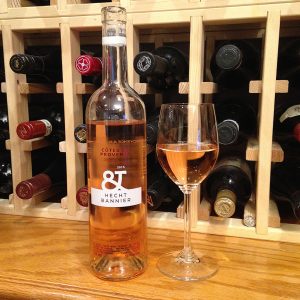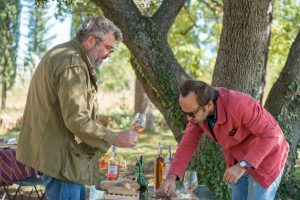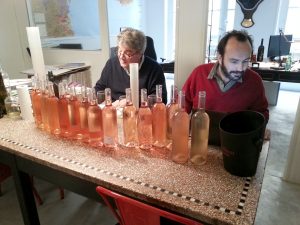Classic light orange Provence rosé color; flowers with some orange zest and red berries on the nose; pink grapefruit, clementines, raspberry, strawberry, and red currant tang on the palate.
Quite silky and refreshing with good acidity and minerality; nice balance; nice red currant base to the citrus fruits, throw some orange zest into the mix on some sips. Bright, refreshing easy drinker, particularly smooth on the mid-palate and finish after the initial citrus and acidity attack. Blend of 45% grenache, 40% cinsault, 15% syrah, with the generous syrah percentage adding the red currant tang and riff of raspberry.
Quite attractive example of how special is Provence rosé. The Provence region is west of Languedoc-Roussillon in southern France along the border with Spain. Wine has been made there for 2,600 years, since the ancient Greeks founded the city of Marseille. The wine region, thus, reflects influence of Greeks, Romans, Gauls, Catalans, Savoyards, Spaniards and Italians. It is this millennia-deep knowledge that makes special Old World wines special and often unique.
The Côtes de Provence AOC covers more than 85 communes (small cities or townships; the name has nothing to do with communist political ideology) and accounts for 75% of wine production in Provence and 80% of that production is rosé. Grenache and cinsaut—principal grape elements of this effort—are major grapes (so is carignan, but none are in this bottle). Syrah is relative newcomer and increasingly being used to provide its distinctive raspberry and red currant elements. By AOC rule, at least 20% of the wine must be made using the saignée (bleed) method in which some of the juice is bled from the must (freshly pressed juice) in order to provide the concentrated phenolics, color, and flavor of the red wine.
Provence wine makers also have a proclivity to unusual bottle shapes or closures, and this effort qualifies with a glass “cork” that presents a mild challenge. Twisting will not do much, but gently prying the closure up eventually will disengage the plastic ribs and free the closure. The closure really is the ribbed plastic, the glass is just the base-handle.
Gregory Hecht and François Bannier are négociants—merchants who assemble the grapes and other wine components from smaller growers and make and sell the resulting wine under their own names. Négociants stand in contrast to “estate bottled” or “single vineyard” wines made on premises by producers who grow their own grapes. The estate bottled folk may stand at the apex of the wine pyramid, but négociants can be only a tissue paper below them and their wines are much more likely to be affordable and available to the typical wine drinker (and follower of my wine blog or reader of my newspaper wine column). Some estates bottle their own juice AND are négociants for other production. Bottom line: judge the wine, not the production method.
Hecht & Bannier Côtes de Provence Rosé AOC 2015 is yet another reason rosé should be on your wine drinking dance card. Refreshing, clean, good acidity and minerality, alluring evolution of taste in the mouth. $21
Other photos: Hecht and Bannier; blending the wine.



